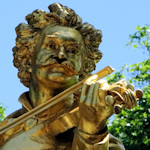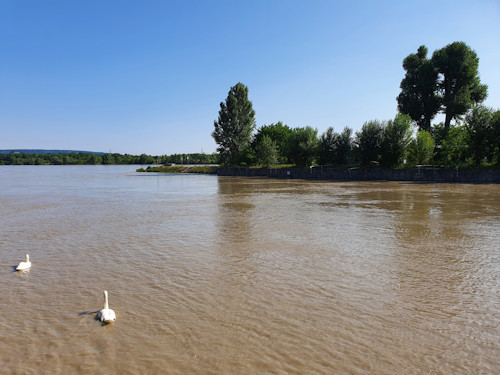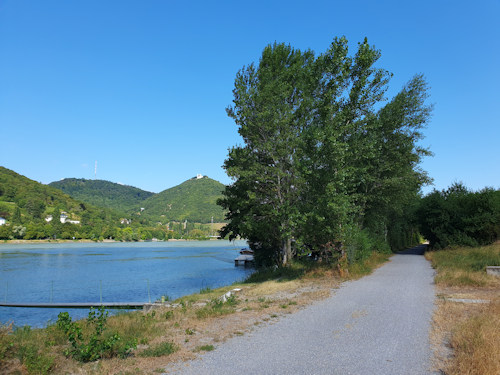
No. It’s not. OK, maybe sometimes. But the Blue Danube waltz at least remains a reliable constant.
- Music composed in 1866 by Johann Strauss II
- Still immensely popular today
- Common feature of local concerts & events
- Browse concert experiences* in Vienna
- See also:
Really not blue?
So, no, the river rarely assumes a lovely shade of azure. As this photo demonstrates:
(Distinctly non-cyan)
The Danube can certainly be blue(ish). If it’s a sunny, cloudless day and the river is relatively placid. The more usual colour is a mundane grey or a little muddy when rain washes soil into the waters or a storm drives up the silt.
The question is, of course, legitimate, given the name of one of the most recognisable pieces of music in history: the Blue Danube (the most famous part kicks in after around 1 minute and 40 seconds).
Johann Strauss II composed the waltz, though he didn’t give it the name we associate with the piece.
The German title was “An der schönen blauen Donau”, which translates literally as “On the beautiful blue Danube”.
(Possibly blue after all)
You can even visit the very apartment where Strauss wrote the work in 1866, when he lived in what is now Vienna’s second district (Leopoldstadt).
The original version for choir and orchestra premiered to broad approval on February 17th, 1867, in the Dianabad public baths (which converted to a concert hall out of season).
The Die Debatte paper described it as a “huge and deserved triumph”, while Die Presse noted prophetically (my translation):
This lovely waltz with its fine mellifluous rhythms is sure to become one of the most popular of the seminal dance compositions
Ad:
The music remains deeply ingrained in Viennese life. Locals know it as the “Donauwalzer” or “Danube Waltz” (nothing blue about it at all), and it invariably forms the highlight of Vienna’s many balls.
Once the midnight chimes die away, the entire city (and Austria as a whole) also welcomes in the New Year by dancing to the Blue Danube. It’s an irreplaceable cornerstone of the New Year’s concert given by the Wiener Philharmoniker, too.
And if you attend one of the many Mozart and Strauss concerts so popular with visitors, then you’re almost certain to hear the melody at some point.

(The composer photographed by Xaver Massak in 1870; Wien Museum Inv.-Nr. 76966/2; excerpt reproduced with permission under the terms of the CC0 licence)
Strauss’s name is indelibly linked with this particular piece, even though he composed hundreds of works of music.
Another Strauss waltz you hear everywhere in Vienna, for example, is the Kaiser Waltz or Emperor Waltz.
Should you wish to pay hommage to the King of the Waltz, then his golden statue sits in the Stadtpark close to the centre of Vienna. And he’s buried in the city, too. Strauss’s grave is in the Zentralfriedhof, alongside those of Beethoven, Brahms, and other great composers.

